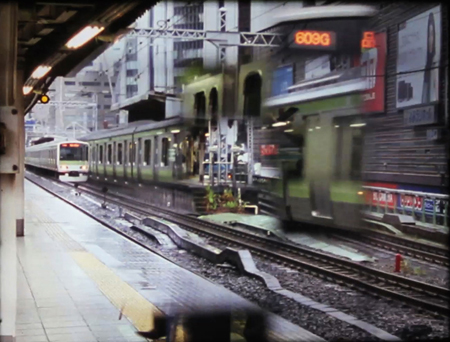April 12, 2012
Tom McCormack in conversation with Tomonari Nishikawa on the occasion of the screening “Tomonari Nishikawa & Small-Gauge Japan,” a program of Super 8 film.
Tom: Many of your films take advantage of a specific formal technique or a set of specific formal techniques. How do you discover these techniques? Is it through playing around or do you derive them in a more abstract way?
Tomonari: I learned some of these techniques from other artists’ works and I found some from my own experiments. For part of Apollo, I shot 16mm filmstrips using a 35mm SLR camera. I first heard about this technique from my teacher Ariana Gerstein at Binghamton University. And Julie Murray, who was my senior thesis adviser, showed me Scott Stark’s Satrapy, one of his The Chromesthetic Response Series, which gave me ideas to work on creating images on the optical soundtrack area. Later, I played more with mismatched formats, which lead me to make 16-18-4, a 35mm film made by a toy camera with 16 lenses, and an installation, A Pinhole Behind Fences, for which I shot a series of 16mm filmstrips with a pinhole camera, so that a single picture would spread onto numerous frames on 16mm films.
Tom: Many of your movies explore a specific place and could be thought of as landscape films or city symphonies. Do you have attachments to these places? Emotional attachments? Things you would like to say about them? Or are they more abstract spaces?
Tomonari: Most of my works show the environments where I have been, and, for some projects, I have emotional attachments to these places. Into the Mass is shot in San Francisco, and I made it because I wanted to make something about my experience of going to and from my studio at the Headlands Center for the Arts, which took about 60 minutes by bicycle, along with my experience of riding the bicycle in the city for about three years. The idea of Tokyo – Ebisu and Shibuya –Tokyo came to my mind when I was living in Tokyo in 2007-08, when I often used the JR Yamanote Line, where I shot these films.
Tom: A lot of your work can be seen as taking an abstract or geometric language and using things in the real world to build it up or flesh it out. Why use natural objects in this way? Or, conversely, why geometry and abstraction?
Tomonari: I am interested in abstracting representational images, especially by shooting methods or in-camera editing. It may sound similar to how a painter makes an abstract painting from direct-observation, and it is true for Clear Blue Sky, but for the single-framed films, I try to produce abstract time and space from real time and space, letting the viewers be aware of human visual perception and the cinema apparatus. I am also interested in shooting in the real world, documenting the environments at the time when I am there, even though it is getting more difficult to shoot in the public space.
Tom: How have you found different audiences experience your work?
Tomonari: Some audiences seemed to have found my works interesting because of the visual appearances, while others seemed to have not enjoyed them, maybe because there was no narrative. I often have questions about filming and editing techniques after a screening.
Tom: Are there contemporary filmmakers or artists using other mediums who you feel connected to?
Tomonari: Thinking of my interests in medium, format, visual perception and cinema apparatus, I feel connected to James Benning, Steve Cossman, Kelly Egan, Chris Kennedy, Kerry Laitala, Bruce McClure, Katherin McInnis, Ben Russell, Daichi Saito, and Scott Stark. There are works by contemporary artists in other fields, especially photography, who share similar interests, but I do not feel connected to them.
Tom: In the earliest work of yours I’ve seen, you used a pinhole camera to expose a roll of film all at once, creating a sort of mosaic across different strips of 16mm. This work was obviously very connected to film as a physical object: do you see your other work connected to this materiality in the same way?
Tomonari: Yes, I do, for some other works. The work you have mentioned is an installation, and showing the filmstrips along with the moving image is one of the main concepts of the project. Sketch Film #1, #2, #3, and #5 were hand-processed, and thus there are many scratches on the emulsion, so that the films would show materiality. The length of each shot in Tokyo – Ebisu and Shibuya- Tokyo is determined by the length that a spring-motor Bolex camera can shoot on a full-wind. When the camera stops filming, the shutter sometimes stops at an open position, and, as a result, it makes a flash frame, an over-exposed frame, which would also show materiality of the medium.
